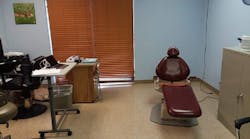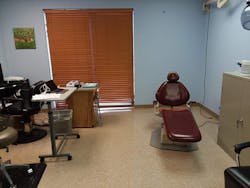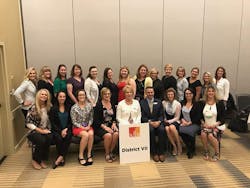Direct access and the dental hygienist
Melissa Turner, BASDH, CPDH, EFDA
The American Dental Hygienists’ Association (ADHA) defines direct access as the ability of a dental hygienist to initiate treatment based on his or her assessment of a patient’s needs without the specific authorization of a dentist, treat the patient without the presence of a dentist, and maintain a provider-patient relationship.1
The ongoing conversation about direct access to dental hygiene services has been long and complicated, filled with joyous advances and a few bumps along the way. But thanks to the support of organizations such as the US Department of Health and Human Services, the Centers for Medicare and Medicaid, the Pew Charitable Trusts, and the American Dental Hygienists’ Association, the dental hygiene profession has indeed expanded significantly in the face of adversity during the last 20 years.
In 2008, nearly half of all state practice acts allowed dental hygienists to provide care only with the authorization and onsite presence of a supervising dentist. But as the conversation about direct access gained momentum on both local and national levels, stakeholders realized the value of increased public access to dental hygienists. Fast-forward to today and regulations in at least 42 states contain provisions for direct access to care.2
Amy Ericks, BSDH, RDH, makes do with a temporary operatory in what is normally the salon in the care facility where she works.
That being said, the very definition of “direct access” depends on individual state legislation and varies significantly from state to state, which can often be confusing for everyone involved. Take the following regulations as examples:
• In Alaska, a written agreement with a supervising dentist is necessary to provide direct services outside of the dental hygienist’s usual place of practice.
• In California, those wishing to provide direct services must document 1,200 hours of clinical practice during the preceding 36 months and 150 hours of further education.
• In Arkansas, dental hygienists with 1,800 hours of clinical experience may provide direct services onlyto children, seniors, and those with developmental disabilities.
Let’s not forget about states such as Colorado and Maine, where dental hygienists are independent, can own a dental practice, and have no limitations on who they can treat!2 Are you confused yet?
With the rise of a new workforce that consists primarily of millennials—who tend to embrace more nomadic lifestyles than their predecessors—it is more important than ever to be familiar with what it actually means to be a dental hygienist in different parts of the country. As evidenced by the frequent and lengthy discussions within online dental communities, even dental hygienists are confused as to what direct access means for the profession.
State: South Dakota
Here we turn the spotlight on South Dakota. Since 2011, dental hygienists in South Dakota have had the option of providing direct preventive and therapeutic services in limited, specified settings. To qualify, a dental hygienist must apply to the board of dentistry, meet clinical experience requirements, and form a written collaborative agreement with a supervising dentist. South Dakota statutes are among the few in the country to specifically acknowledge and precisely define the term “teledentistry,” thus making it easier for dental hygienists to also provide direct care through that medium.3
Summary of direct access in South Dakota3
• Title—Collaborative supervision
• Qualifications—Three years of clinical practice in dental hygiene and completion of 4,000 practice hours, of which 2,000 hours must have been completed within the last two out of three years.
• Setting limitations—Some of the settings where hygienists can practice are schools, nursing facilities, Head Start programs, mobile or portable units operated by a nonprofit organization, community-based primary health-care delivery organizations, or state-run programs.
• Scope of practice limitations—May provide full scope of services with the exception of administration of local anesthesia and nitrous oxide inhalation analgesia.
• Written collaborative agreement needed?—Yes
• In-person evaluation by a dentist required?—No; however, an oral health review is required every 13 months. An oral health review is a limited assessment of a patient’s health by the collaborating dentist, which includes a review of the patient’s medical and dental history after a limited clinical inspection by a collaborative dental hygienist.
• Dental hygiene diagnosis defined?—No
• Prescriptive authority needed?—No
• Supervision of dental assistants permitted?—Yes
• Direct reimbursement allowed?—No
Meet Amy Ericks, BSDH, RDH
Amy Ericks, BSDH, RDH, provides direct patient care to residents of local nursing facilities in South Dakota, and she is currently serving as president of the South Dakota Dental Hygienists’ Association. Graduating with her dental hygiene degree in 2010, Amy completed a BSDH in 2015, and today she advocates for the profession to be recognized as oral health prevention specialists. Read on to learn about her successes, struggles, and why she thinks it’s critical for dental hygienists to provide direct care to patients.
Members of the District VII ADHA
How do you currently use direct services?
My services are fairly basic at this time and are limited to providing prophylaxis, fluoride varnish applications, and collaborating with my supervising dentist to complete oral health reviews. Each patient is referred to a general dentist for routine or immediate care if obvious issues are present. I do not own the practice. Instead, I’m an employee of my collaborating dentist. I set up my op in the beauty shop of the nursing facility, and it includes a stationary dental chair, suction unit, and basic supplies. I see 75% of my patients in the beauty shop and treat the rest of the patients in their rooms.
What inspired you to pursue direct access to care?
While completing clinical rotations during hygiene school, I remember providing care to patients in a nursing facility. The lack of dental care shocked me then, and those feelings never went away. I often thought that I should be able to do more for this neglected population, and I’m happy to say that for the past year I’ve been doing so successfully! Providing direct access has allowed me to gain a more meaningful purpose in my career.
Why is it important for dental hygienists to provide direct care to patients?
The dental profession already recognizes many specialties in the treatment of dental disease—endodontists, periodontists, prosthodontists, and orthodontists to name a few. All of these specialists manage some aspect of dental disease, but there is currently no one managing the disease from a prevention standpoint. Because dental hygienists are unique in the fact that we spend the most time with patients providing oral health education, guidance on home care products and tools, nutritional counseling, and individualized oral health management, I prefer to think of dental hygienists as specialists in prevention.
What has been the most effective way to build a patient base?
I acquire patients mostly by word of mouth. I work closely with a staff member at the nursing home who seeks out families as they visit their loved ones. This staff member then presents the service, provides necessary paperwork, and passes the referral on to me.
How does reimbursement work?
Because I practice as an employee of my collaborating dentist, the dentist is reimbursed for my services. I earn a percentage of incoming payments from Medicaid, private insurances, and direct fee-for-service.
Are you required to refer a patient to a dentist?
South Dakota statutes require my patients to have an oral health review every 13 months in order for me to continue care. I am also required to advise patients that the services I provide in no way replace care received within a dental office.
What three tools can you not live without?
I cannot live without communication through email, text, and social media. Along with that, I consider my vast professional network a tool as they are my support, my guidance, and my friends. I also cannot live without the courage and backing from my faith and family; they are daily reminders of the reasons why I do what I do.
What would you like to change about your clinical program?
In the past I was able to provide services through teledentistry. Specifically, I used an intraoral camera and teledentistry software from MouthWatch to complete real-time exams and record assessments to view later. This was convenient as my collaborating dentist was not always available for live exams. Teledentistry has also been valuable in educating patients’ families and care teams. Even though South Dakota has yet to reimburse for teledentistry services, it is still useful to bring education and awareness to patients. I foresee teledentistry becoming a standard option for patients who face barriers to care, and also as a way to bring dental care and screenings to primary care offices, obstetrics and oncology clinics, schools, and more. Teledentistry is amazing, and I’m excited to watch it grow!
What obstacles have you faced during your journey?
I’ve faced several! Acquiring equipment, seeking a facility that wanted me to provide care, and even finding a dentist who was willing to supervise me were all significant obstacles. Even after securing a facility, there has been staff pushback as they do not see the importance of oral health and they feel I’m simply adding more tasks to their already large list of responsibilities. Also, at one point in the process I needed confirmation of work history from a previous employer. The employer refused to complete the necessary paperwork! This had the potential to prevent me from being able to provide any direct care. Finally, navigating the state practice act and determining how to create and manage the mobile program was an obstacle in itself.
What is your ultimate professional goal?
In general, I truly believe that we can improve oral health through early intervention and education. To me, this can be done by dental hygienists providing services and collaborating with medical professionals in many different locations. It is my goal to begin this movement on the local level in my community. I am actively involved in my state hygiene association so that I can seek changes in our local regulations that will allow us to provide this much-needed care and oral health education.
Where do you hope to be in 10 years?
I hope to still be working part-time clinically as well as providing education and care outside of the traditional operatory. In the meantime, I will work diligently to change South Dakota’s state regulations so I can do just that.
What advice would you give to someone who wants to begin a similar journey?
Keep working hard and don’t give up! Don’t be afraid to ask for help and guidance. Don’t be discouraged when you are told no. Don’t expect things to move quickly orsmoothly. Don’t let others tell you that you can’t accomplish your goals. If you aren’t already involved in your professional association, please do so! Also, begin to share your knowledge and experience with others; learn from others and let them learn from you.
Is there anything you would change about your current position?
Many people are not aware of the vast knowledge and education that dental hygienists must have to “clean” teeth. Because of this, I hope to bring more respect and awareness to the dental hygiene profession. Increased awareness will lead to increased opportunities for dental hygienists in other nontraditional capacities.
Who do you consider a mentor in your professional journey?
Pat Aylward, RDH, also practices under collaborative supervision and has been a huge inspiration for me. She has freely given her time and knowledge to help me in my journey and has had amazing experiences that allow her to look at situations from many different angles. Pat is constantly seeking new opportunities to network, and she helps broaden my views by encouraging me to see things from different perspectives.
References
1. Direct Access States. American Dental Hygienists’ Association. https://www.adha.org/resources-docs/7513_Direct_Access_to_Care_from_DH.pdf.
2. Variation in dental hygiene scope of practice by state. Oral Health Workforce Research Center website. http://www.oralhealthworkforce.org/resources/variation-in-dental-hygiene-scope-of-practice-by-state/.
3. South Dakota Dental Practice Act. South Dakota State Board of Dentistry website. https://www.sdboardofdentistry.com/userfiles/file/Practice%20Act%207-2-12.pdf.
Melissa Turner, BASDH, CPDH, EFDA, practices independent clinical hygiene in Minnesota under a collaborative practice agreement. She is director of volunteer operations for Operation Grace Minnesota. She played a key role in an attempt to increase access to oral health care and oral health literacy. She is an active leader in the Minnesota DHA and is executive moderator for the Dental Peeps Network. She is also the founder of I Heart Mobile Dentistry, a Facebook group for clinicians practicing mobile dentistry.
Editor’s note: Join us as we continue our series of highlighting direct access to dental hygiene services across the country. In the first segment, we explored the ability of Colorado dental hygienists to provide completely independent services. Today we turn the spotlight on South Dakota, where dental hygienists are able to provide direct care to underserved communities via collaborative supervision.








